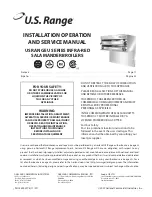
34
Part Number 550-142-320/0720
GWA
Series 3
Gas-Fired Water Boilers –
Boiler Manual
Air vents and air elimination
1. Inspect automatic air vents (if used). Also inspect air
separators to ensure they are operational.
2. The cap must be unscrewed one turn to allow air to escape.
3. If the air vent is leaking, remove cap and briefly push valve
— then release to clean the valve seat.
4. Replace cap by twisting all the way onto valve and then
unscrewing one turn.
Limit controls and cutoffs
1. Inspect and test the boiler limit control. Verify operation by
turning control set point below boiler temperature. Boiler
should cycle off. Return dial to original setting.
2. Inspect and test additional limit controls or low water cutoffs
installed on system.
Expansion tank
1. Expansion tanks provide space for water to move in an out
as the heating system water expands due to temperature
increase or contracts as the water cools. Tanks may be
open, closed or diaphragm or bladder type. See
Section 3,
page 10
of this manual for suggested locations of expansion
tanks and air eliminators.
Open-type
— located above highest radiator or baseboard
unit, usually in the attic or closet. Has a gauge glass and
overflow pipe to a drain.
Closed-type
— welded gas tight and located above boiler.
Tank is partially filled with water, leaving an air cushion for
expansion.
• Make sure this type of tank is fitted with a tank fitting,
such as the B & G Tank-Trol or Taco Taco-Trol. This fitting
reduces gravity circulation of air-saturated tank water
back to the system and prevents the air from bubbling
up through the water as it returns from the system.
• Do not use automatic air vents in systems with closed-
type tanks. The air will escape from the system instead
of returning to the tank. Eventually, the tank will waterlog
and no longer control pressurization. The boiler relief
valve will weep frequently.
12 Service and maintenance
continued
o
Check/test. . . . . . . . . .
Gas piping
1. Sniff near floor and around boiler area for any indication of
a gas leak.
2. Test gas piping using bubble test, per
Section 5, page 19
of this manual, if there is any indication of a leak.
Cold fill and operating pressures
1. While the system is cold, note the pressure reading on
the boiler pressure/temperature gauge. Verify that cold fill
pressure is correct.
2. Watch the pressure as the boiler and system heat up
to ensure pressure rise is normal. Too high a rise would
indicate a waterlogged or undersized expansion tank.
o
Start-up. . . . . . . . . .
1. Perform start-up procedures
Section 7, pages 22– 24
, in-
cluding “Verify operation” of burners and vent damper on
page 24.
2. Verify cold fill pressure is correct and that fill system is
working properly.
3. Verify antifreeze level (if used) is at the right concentration
and that inhibitor level is correct.
4. Check gas piping, per Manual
Section 5, page 20
and
Sec-
tion 7, page 22,
verifying no indications of leakage and all
piping and connections are in good condition.
5. Read and start the boiler following the “Operating
Instructions” (Manual
Section 10 and 11
,
pages 27
through 31
.
Oiled-bearing circulators
1. The circulator shipped with the GWA boiler is water-lubri-
cated. No oiling is required.
2. Check other circulators in the system. Oil any circulators
requiring oil, following circulator manufacturer’s instruc-
tions. Over-oiling will damage the circulator.
Temperature sensor
1. The temperature sensor may accumulate deposits on the
probe surface. Annual inspection and cleaning of the probe
will improve boiler performance.
Disconnect power, unplug harness from sensor.
a. Drain boiler water to a level below the sensor.
b. Remove sensor from boiler.
c. Wipe any built up contaminates from probe and insulator
surfaces.
d. Reinstall sensor into boiler. Do not overtighten.
e. Refill boiler.
o
Service. . . . . . . . . .
o
Check/test. . . . . . . . . .
















































